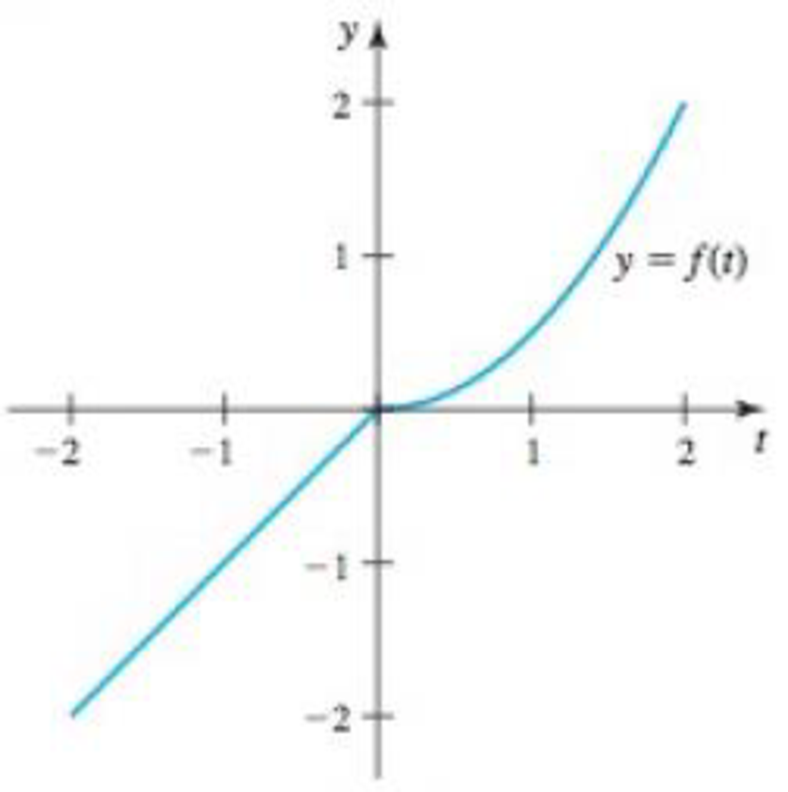Problem 1RE: Explain why or why not Determine whether the following statements are true and give an explanation... Problem 2RE Problem 3RE: Ascent rate of a scuba diver Divers who ascend too quickly in the water risk decompression illness.... Problem 4RE: Use the tabulated values of f to estimate the value of 06f(x)dxby evaluating the left, right, and... Problem 5RE: Estimate 144x+1dx by evaluating the left, right, and midpoint Riemann sums using a regular partition... Problem 6RE Problem 7RE: Estimating a definite integral Use a calculator and midpoint Riemann sums to approximate 1252x1dx.... Problem 8RE: Suppose the expression lim0k=1n(xk3+xk)xk is the limit of a Riemann sum of a function f on [3, 8].... Problem 9RE: Integration by Riemann sums Consider the integral 14(3x2)dx. a. Evaluate the right Riemann sum for... Problem 10RE: Limit definition of the definite integral Use the limit definition of the definite integral with... Problem 11RE: Limit definition of the definite integral Use the limit definition of the definite integral with... Problem 12RE: Limit definition of the definite integral Use the limit definition of the definite integral with... Problem 13RE Problem 14RE: Sum to integral Evaluate the following limit by identifying the integral that it represents:... Problem 15RE: Symmetry properties Suppose that 04f(x)dx=10 and 04g(x)dx=20. Furthermore, suppose that f is an even... Problem 16RE: Properties of integrals The figure shows the areas of regions bounded by the graph of f and the... Problem 17RE: Properties of integrals Suppose that 14f(x)dx=6, and14g(x)dx=4, and 34f(x)dx=2. Evaluate the... Problem 18RE: Properties of integrals Suppose that 14f(x)dx=6, and14g(x)dx=4, and 34f(x)dx=2. Evaluate the... Problem 19RE: Properties of integrals Suppose that 14f(x)dx=6, and14g(x)dx=4, and 34f(x)dx=2. Evaluate the... Problem 20RE: Properties of integrals Suppose that 14f(x)dx=6, and14g(x)dx=4, and 34f(x)dx=2. Evaluate the... Problem 21RE: Properties of integrals Suppose that 14f(x)dx=6, and14g(x)dx=4, and 34f(x)dx=2. Evaluate the... Problem 22RE: Properties of integrals Suppose that 14f(x)dx=6, and14g(x)dx=4, and 34f(x)dx=2. Evaluate the... Problem 23RE: Area by geometry Use geometry to evaluate the following definite integrals, where the graph of f is... Problem 24RE: Displacement by geometry Use geometry to find the displacement of an object moving along a line for... Problem 25RE: Area by geometry Use geometry to evaluate 048xx2dx. (Hint: Complete the square.) Problem 26RE: Use geometry and properties of integrals to evaluate the following definite integrals. 26.... Problem 27RE Problem 28RE Problem 29RE: Evaluate the following derivatives. 29. ddx7x1+t4+t6dt Problem 30RE: Evaluate the following derivatives. 30.ddx3excost2dt Problem 31RE: Evaluate the following derivatives. 31. ddxx5sinw6dw Problem 32RE: Evaluate the following derivatives. 32. ddxx25sinw6dw Problem 33RE: Evaluate the following derivatives. 33. ddxxxdtt10+1 Problem 34RE: Evaluate the following derivatives. 34. ddxx2exsin3tdt Problem 35RE: Find the intervals on which f(x)=x1(t3)(t6)11dt is increasing and the intervals on which it is... Problem 36RE: Area function by geometry Use geometry to find the area A(x) that is bounded by the graph of f(t) =... Problem 37RE: Given that F=f, use the substitution method to show that f(ax+b)dx=1aF(ax+b)+C, for nonzero... Problem 38RE: Evaluating integrals Evaluate the following integrals. 38. 15dx Problem 39RE: Evaluating integrals Evaluate the following integrals. 15. 22(3x42x+1)dx Problem 40RE: Evaluating integrals Evaluate the following integrals. 18. 01(4x212x16+1)dx Problem 41RE: Evaluating integrals Evaluate the following integrals. 19. (9x87x6)dx Problem 42RE: Evaluating integrals Evaluate the following integrals. 42. x+1xdx Problem 43RE: Evaluating integrals Evaluate the following integrals. 21. 01x(x+1)dx Problem 44RE: Evaluating integrals Evaluate the following integrals. 44. (3x+1)(3x2+2x+1)3dx Problem 45RE: Evaluating integrals Evaluate the following integrals. 45. /6/3(sec2t+csc2t)dt Problem 46RE: Evaluating integrals Evaluate the following integrals. 46. /12/9(cos3xcot3x+sec3xtan3x)dx Problem 47RE: Evaluating integrals Evaluate the following integrals. 47. 22dxxx21 Problem 48RE: Evaluating integrals Evaluate the following integrals. 48. 14(v+vv)dv Problem 49RE: Evaluating integrals Evaluate the following integrals. 49. cosxsin7/4xdx Problem 50RE: Evaluating integrals Evaluate the following integrals. 50. 1edxx(1+lnx) Problem 51RE: Evaluating integrals Evaluate the following integrals. 51. x2cosx3dx Problem 52RE: Evaluating integrals Evaluate the following integrals. 52. cos3t1+sin3tdt Problem 53RE: Evaluating integrals Evaluate the following integrals. 53. cos7w16+sin27wdw Problem 54RE: Evaluating integrals Evaluate the following integrals. 54. 1+tan2tsec22tdt Problem 55RE: Evaluating integrals Evaluate the following integrals. 55. 01x2x2+1dx Problem 56RE: Evaluating integrals Evaluate the following integrals. 16. cos3xdx Problem 57RE: Evaluating integrals Evaluate the following integrals. 57. 02(2x+1)3dx Problem 58RE: Evaluating integrals Evaluate the following integrals. 20. 22e4x+8dx Problem 59RE: 015re3r2+2dr Problem 60RE: sinzsin(cosz)dz Problem 61RE: ex+exdx Problem 62RE: Evaluating integrals Evaluate the following integrals. 22. y2y3+27dy Problem 63RE: dx14x2 Problem 64RE: Evaluating integrals Evaluate the following integrals. 24. y2(3y3+1)4dy Problem 65RE: 02cos2x6dx Problem 66RE: Evaluating integrals Evaluate the following integrals. 26. xsinx2cos8x2dx Problem 67RE: Evaluating integrals Evaluate the following integrals. 27. 0sin25d Problem 68RE: Evaluating integrals Evaluate the following integrals. 28. 0(1cos23)d Problem 69RE: Evaluating integrals Evaluate the following integrals. 29. 23x2+2x2x3+3x26xdx Problem 70RE: Evaluating integrals Evaluate the following integrals. 30. 0ln2ex1+e2xdx Problem 71RE Problem 72RE: 33(511x17+302x13+117x9+303x3+x2)dx Problem 73RE: 1x2sin1xdx Problem 74RE: (tan1x)51+x2dx Problem 75RE: dx(tan1x)(1+x2) Problem 76RE: sin1x1x2dx Problem 77RE: x(x+3)10dx Problem 78RE: x7x4+1dx Problem 79RE: Evaluating integrals Evaluate the following integrals. 25. 03x25x2dx Problem 80RE: Evaluating integrals Evaluate the following integrals. 23.01dx4x2 Problem 81RE: 2/52/5dxx25x21 Problem 82RE: sin2x1+cos2xdx (Hint: sin2x=2sinxcosx.) Problem 83RE: 1010x200x2dx Problem 84RE: /2/2(cos2x+cosxsinx3sinx5)dx Problem 85RE: 04f(x)dx for f(x)={2x+1ifx33x2+2x8ifx3 Problem 86RE: 05|2x8|dx Problem 87RE Problem 88RE: Area of regions Compute the area of the region bounded by the graph of f and the x-axis on the given... Problem 89RE Problem 90RE Problem 91RE Problem 92RE: Area versus net area Find (i) the net area and (ii) the area of the region bounded by the graph of f... Problem 93RE: Gateway Arch The Gateway Arch in St Louis is 630 ft high and has a 630-ft base Its shape can be... Problem 94RE: Root mean square The root mean square (or RMS) is another measure of average value, often used with... Problem 95RE: Displacement from velocity A particle moves along a line with a velocity given by v(t) = 5 sin t... Problem 96RE: Velocity to displacement An object travels on the x-axis with a velocity given by v(t) = 2t + 5, for... Problem 97RE: Find the average value of f(x)=e2xon [0, ln 2]. Problem 98RE: Average height A baseball is launched into the outfield on a parabolic trajectory given by y =... Problem 99RE: Average values Integration is not needed. a. Find the average value of f shown in the figure on the... Problem 100RE Problem 101RE: An unknown function Assume f is continuous on [2, 4], 12f(2x)dx=10,and f(2) = 4. Evaluate f(4). Problem 102RE Problem 103RE Problem 104RE: Change of variables Use the change of variables u3 = x2 1 to evaluate the integral 13xx213dx. Problem 105RE Problem 106RE: Area functions and the Fundamental Theorem Consider the function f(t)={tif2t0t22if0t2 and its graph... Problem 107RE: Limits with integrals Evaluate the following limits. 57. limx22xet2dtx2 Problem 108RE: Limits with integrals Evaluate the following limits. 58. limx11x2et3dtx1 Problem 109RE Problem 110RE: Area with a parameter Let a 0 be a real number and consider the family of functions f(x) = sin ax... Problem 111RE: Inverse tangent integral Prove that for nonzero constants a and b, dxa2x2+b2=1abtan1(axb)+C Problem 112RE Problem 113RE Problem 114RE: Exponential inequalities Sketch a graph of f(t) = et on an arbitrary interval [a, b]. Use the graph... Problem 115RE: Equivalent equations Explain why if a function u satisfies the equation u(x)+20xu(t)dt=10, then it... Problem 116RE: Unit area sine curve Find the value of c such that the region bounded by y=csinxand the x-axis on... Problem 117RE: Unit area cubic Find the value of c0 such that the region bounded by the cubic y=x(xc)2 and the... format_list_bulleted



